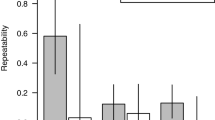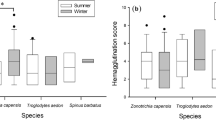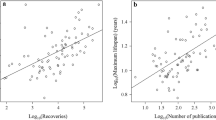Abstract
Micronutrient antioxidants are thought to be generally important for health in many animals, but factors determining levels in individuals and species are not well understood. Diet and season are obvious environmental variables that might predict the degree to which species can accumulate such nutrients. We analyzed antioxidant levels [Trolox-equivalent antioxidant capacity (TEAC), uric acid (UA), vitamin E, and four carotenoids] in 95 bird species and compared these to species-level data on diet from the literature. Using compositional principal components analysis, we identified two main axes of diet variation: invertebrate consumption and seed-to-fruit ratio. We then examined associations between diet axes and antioxidant measures, with and without control for life-history variation and phylogeny. We also analyzed a subset of 13 species for which we had data on seasonality of antioxidant levels and diet, assessing the variance in antioxidant levels explained by seasonality, diet, and species. Unsurprisingly, there were strong associations between antioxidant levels and diet. TEAC and UA concentration were consistently positively associated with invertebrate consumption and seed-to-fruit ratio, and carotenoid concentrations (e.g. zeaxanthin and β-carotene) were negatively associated with invertebrate consumption. However, vitamin E was not associated with diet as measured here. Importantly, there is much variation in antioxidants that is not explained by diet, and we are able to identify diet-independent effects of species, season/breeding stage, and life history on antioxidant levels. Circulating antioxidant concentrations within and across species can therefore be viewed as a function of multiple factors, including but not limited to diet, and antioxidant metabolism appears to differ across species and seasons irrespective of diet.

Similar content being viewed by others
References
Aitchison J (1982) The statistical analysis of compositional data. J R Stat Soc B 44:139–177
Aitchison J (1983) Principal component analysis of compositional data. Biometrika 70:57–65
Alonso-Alvarez C, Bertrand S, Faivre B, Sorci G (2007) Increased susceptibility to oxidative damage as a cost of accelerated somatic growth in zebra finches. Funct Ecol 21:873–879
Barker D, Fitzpatrick MP, Dierenfeld ES (1998) Nutrient composition of selected whole invertebrates. Zoo Biol 17:123–134
Bertrand S, Faivre B, Sorci G (2006) Do carotenoid-based sexual traits signal the availability of non-pigmentary antioxidants? J Exp Biol 209:4414–4419
Blount JD, Metcalfe NB, Birkhead TR, Surai PF (2003) Carotenoid modulation of immune function and sexual attractiveness in zebra finches. Science 300:125–127
Cohen AA (2007) The role of antioxidants in the physiology, ecology, and life histories of wild birds. Department of Biology, University of Missouri-St. Louis, St. Louis, MO
Cohen AA, McGraw KJ (2009) No simple measures for antioxidant status in birds: complexity in inter- and intraspecific correlations among circulating antioxidant types. Funct Ecol 23:310–320
Cohen AA, Klasing KC, Ricklefs RE (2007) Measuring circulating antioxidants in wild birds. Comp Biochem Physiol B 147:110–121
Cohen AA, Hau M, Wikelski M (2008a) Stress, metabolism, and antioxidants in two wild passerine bird species. Physiol Biochem Zool 81:463–472
Cohen AA, McGraw KJ, Wiersma P, Williams JB, Robinson WD, Robinson TR, Brawn JD, Ricklefs RE (2008b) Interspecific associations between circulating antioxidant levels and life history variation in birds. Am Nat 172:178–193
Costantini D, Dell’Omo G (2006) Effects of T-cell-mediated immune response on avian oxidative stress. Comp Biochem Physiol A 145:137–142
Costantini D, Møller AP (2008) Carotenoids are minor antioxidants for birds. Funct Ecol 22:367–370
Costantini D, Cardinale M, Carere C (2007a) Oxidative damage and anti-oxidant capacity in two migratory bird species at a stop-over site. Comp Biochem Physiol C 144:363–371
Costantini D, Fanfani A, Dell’Omo G (2007b) Carotenoid availability does not limit the capability of nestling kestrels (Falco tinnunculus) to cope with oxidative stress. J Exp Biol 210:1238–1244
Deviche P, McGraw KJ, Underwood J (2008) Season-, sex-, and age-specific accumulation of plasma carotenoid pigments in free-ranging white-winged crossbills Loxia leucoptera. J Avian Biol 39:283–292
Freckleton RP, Harvey PH, Pagel M (2002) Phylogenetic analysis and comparative data: a test and review of evidence. Am Nat 160:712–726
Grafen A (1989) The phylogenetic regression. Philos Trans R Soc Lond B 326:119–157
Grafen A (2006) Phylogenetic regression SAS implementation. In: A user's guide to the SAS implementation of the phylogenetic regression, version 0.7. http://www.users.ox.ac.uk/*grafen/phylo/phyman.pdf
Grether GF, Hudon J, Millie DF (1999) Carotenoid limitation of sexual coloration along an environmental gradient in guppies. Proc R Soc Lond B 266:1317–1322
Hartley RC, Kennedy MW (2004) Are carotenoids a red herring in sexual display? Trends Ecol Evol 19:353–354
Hill GE (2000) Energetic constraints on expression of carotenoid-based plumage coloration. J Avian Biol 31:559–566
Hill GE (2006) Environmental regulation of ornamental coloration. In: Hill GE, McGraw KJ (eds) Bird coloration. Harvard University Press, Cambridge, MA, pp 507–560
Hill GE, Inouye CY, Montgomerie R (2002) Dietary carotenoids predict plumage coloration in wild house finches. Proc R Soc Lond B 269:1119–1124
Hõrak P, Saks L, Zilmer Z, Karu U, Zilmer K (2007) Do dietary antioxidants alleviate the cost of immune activation? An experiment with greenfinches. Am Nat 170:625–635
Huang H-Y et al (2005) The effects of vitamin C supplementation on serum concentrations of uric acid: results of a randomized controlled trial. Arthritis Rheum 52:1843–1847
Isaksson C, Andersson S (2008) Oxidative stress does not influence carotenoid mobilization and plumage pigmentation. Proc R Soc Lond B 275:309–314
Khachik F, Chang A-N, Gana A, Mazzola E (2007) Partial synthesis of (3R, 6′R) alpha-Cryptoxanthin and (3R) beta-Cryptoxanthin from (3R, 3′R, 6′R)-Lutein. J Nat Prod 70:220–226
Kiron V, Puangkaew J, Ishizaka K, Satoh S, Watanabe T (2004) Antioxidant status and nonspecific immune responses in rainbow trout (Oncorhynchus mykiss) fed two levels of vitamin E along with three lipid sources. Aquaculture 234:361–379
Mahler B, Araujo LS, Tubaro PL (2003) Dietary and sexual correlates of carotenoid pigment expression in dove plumage. Condor 105:258–267
McGraw KJ (2005) Interspecific variation in dietary carotenoid assimilation in birds: links to phylogeny and color ornamentation. Comp Biochem Physiol B 142:245–250
McGraw KJ (2006) The mechanics of carotenoid coloration in birds. In: Hill GE, McGraw KJ (eds) Bird coloration I. Mechanisms and measurements. Harvard University Press, Cambridge, MA, pp 177–242
McGraw KJ, Ardia DR (2003) Carotenoids, immunocompetence, and the information content of sexual colors: an experimental test. Am Nat 162:704–712
McGraw KJ, Hill GE, Stradi R, Parker RS (2001) The influence of carotenoid acquisition and utilization on the maintenance of species-typical plumage pigmentation in male American goldfinches (Carduelis tristis) and northern cardinalis (Cardinalis cardinalis). Physiol Biochem Zool 74:843–852
McGraw KJ, Adkins-Regan E, Parker RS (2002) Anhydrolutein in the zebra finch: a new, metabolically derived carotenoid in birds. Comp Biochem Physiol B 132:811–818
McGraw KJ, Gregory AJ, Parker RS, Adkins-Regan E (2003) Diet, plasma carotenoids, and sexual coloration in the Zebra Finch (Taeniopygia guttata). Auk 120:400–410
McGraw KJ, Hill GE, Parker RS (2005) The physiological costs of being colourful: nutritional control of carotenoid utilization in the American goldfinch (Carduelis tristis). Anim Behav 69:653–660
McGraw KJ, Nolan PM, Crino OL (2006) Carotenoid accumulation strategies for becoming a colorful house finch: analyses of plasma and liver pigments in wild molting birds. Funct Ecol 20:678–688
McLaughlin PJ, Weihrauch JL (1979) Vitamin E content of foods. J Am Diet Assoc 75:647–665
Negro JJ, Bortolotti GR, Tella JL, Fernie KJ, Bird DM (1998) Regulation of integumentary colour and plasma carotenoids in American Kestrels consistent with sexual selection theory. Funct Ecol 12:307–312
Olson VA, Owens IPF (2005) Interspecific variation in the use of carotenoid-based coloration in birds: diet, life history and phylogeny. J Evol Biol 18:1534–1546
Pérez-Campo R, López-Torres M, Rojas C, Cadenas S, Barja G (1994) Longevity and antioxidant enzymes, non-enzymatic antioxidants and oxidative stress in the vertebrate lung: a comparative study. J Comp Physiol B 63:682–689
Sokal RR, Rohlf JF (1969) Biometry. Freeman, San Francisco
Stryker WS, Kaplan LA, Stem EA, Stampfer MJ, Sober A, Willett WC (1988) The relation of diet, cigarette smoking, and alcohol consumption to plasma beta-carotene and alpha-tocopherol levels. Am J Epidemiol 127:283–296
Surai PF, Speake BK, Wood NAR, Blount JD, Bortolotti GR, Sparks NHC (2001) Carotenoid discrimination by the avian embryo: a lesson from wild birds. Comp Biochem Physiol B 128B:743–750
Tella JL et al (2004) Ecological, morphological and phylogenetic correlates of interspecific variation in plasma carotenoid concentration in birds. J Evol Biol 17:156–164
Tsahar E, Arad Z, Izhaki I, Guglielmo CG (2006) The relationship between uric acid and its oxidative product allantoin: a potential indicator for the evaluation of oxidative stress in birds. J Comp Physiol B 176:653–661
Wang Y, Connor SL, Wang W, Johnson EJ, Connor WE (2007) The selective retention of lutein, meso-zeaxanthin and zeaxanthin in the retina of chicks fed a xanthophyll-free dietstar, open. Exp Eye Res 84:591–598
Wingfield JC, Farner DS (1993) Endocrinology of reproduction in wild species. In: Farner DS, King JR, Parkes KC (eds) Avian biology, vol IX. Harcourt Brace, London, pp 163–327
Wyss A, Wirtz GM, Woggon WD, Brugger R, Wyss M, Friedlein A, Riss G, Bachmann H, Hunziker W (2001) Expression pattern and localization of b,b-carotene 15,15′-dioxygenase in different tissues. Biochem J 354:521–529
Acknowledgments
We thank R. E. Ricklefs, J. D. Brawn, P. Wiersma, J. B. Williams, and T. R. Robinson for the life history data used here. Field and lab help was provided by the Jack Cerchiara, Trevor Rivers, and the K. C. Klasing, M. Wikelski, and M. Hau labs. G. van den Bogaart helped with compositional analysis. David Costantini and three anonymous reviewers provided helpful comments on the manuscript. A.A.C. and some research expenses were supported by a Howard Hughes Medical Institute predoctoral fellowship; sampling was conducted under NSF IBN-0212587. Field support was received from the Kellogg Biological Station and Smithsonian Tropical Research Institute. All research was conducted in accordance with the laws of the United States and Panama and with the approval of the University of Missouri-St. Louis Institutional Animal Care and Use Committee.
Author information
Authors and Affiliations
Corresponding author
Additional information
Communicated by Jacek Radwan.
Electronic supplementary material
Below is the link to the electronic supplementary material.
Rights and permissions
About this article
Cite this article
Cohen, A.A., McGraw, K.J. & Robinson, W.D. Serum antioxidant levels in wild birds vary in relation to diet, season, life history strategy, and species. Oecologia 161, 673–683 (2009). https://doi.org/10.1007/s00442-009-1423-9
Received:
Accepted:
Published:
Issue Date:
DOI: https://doi.org/10.1007/s00442-009-1423-9




